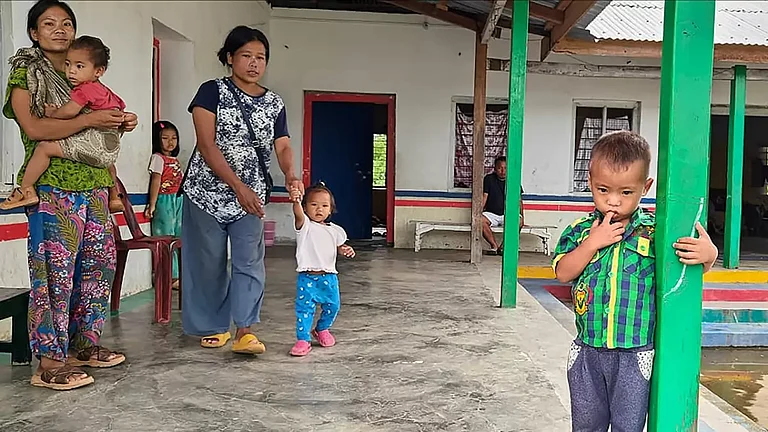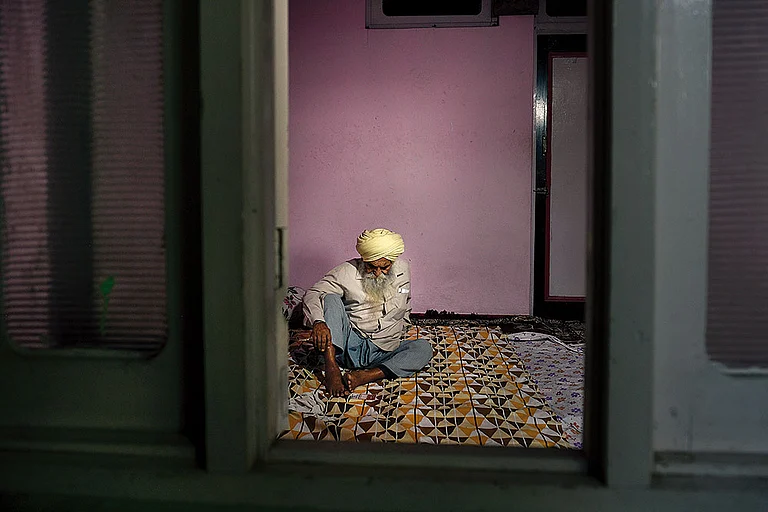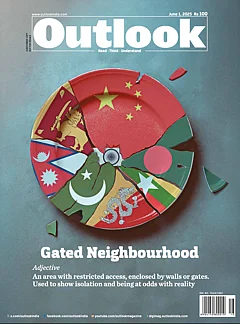On February 27, a rather intriguing political development played out in Aizawl, the capital of Mizoram, India’s northeast state sharing borders with Bangladesh and Myanmar. Two Myanmar-based ethnic insurgent groups signed a merger agreement in the presence of Mizoram Chief Minister Lalduhoma.
The Chinland Council (CC) has been active in western Myanmar’s Chin State for several years, while the Interim Chin National Consultative Council (ICNCC) was launched in 2021, mostly by breakaway factions of the CC. Both groups are fighting against Myanmar’s military junta, which seized power in a coup that overthrew the democratically elected government in February 2021.
Chief Minister Lalduhoma attributed his role in facilitating the CC’s merger with the ICNCC to his mission to support the Chin people’s struggle against Myanmar’s junta rulers. The united body formed through the merger is named the Chin National Council (CNC).
The Mizos of India’s Mizoram, the Kukis of neighbouring Manipur, the Chins of Myanmar’s Chin and surrounding states and the Bawms of Bangladesh’s Chittagong Hill Tracts belong to the same ethnic group—collectively known as the Zo people. Though divided by international and state borders, they share a historic ethnic bond.
Nevertheless, an Indian Chief Minister’s efforts to unify ethnic insurgent groups of Myanmar was a striking development, considering that India has maintained a dual approach in Myanmar since the February 2021 coup. India did not formally acknowledge the junta government but continued official relations to safeguard its economic and strategic interests. It also hosted individuals from the pro-democracy opposition camp at a seminar in New Delhi.
The Aizawl development came amidst repeated allegations by Meitei and Naga armed groups from Manipur and Nagaland that a section of Indian security forces were aiding Kuki-Chin insurgents based in Manipur and Myanmar. The Kuki insurgents were, in turn, targeting India’s Meitei and Naga separatist groups, who operate out of Myanmar in coordination with the junta forces.
Lalduhoma’s party’s strong support for the cause of the Zo people in Myanmar triggered speculation over whether India was increasing its engagement with rebel groups from Chin State, particularly those of Zo ethnic background, who now control large tracts along Myanmar’s border with India.
However, in April, Prime Minister Narendra Modi met the junta leader, Senior General Min Aung Hlaing, for the first time since the coup, on the sidelines of the BIMSTEC Summit in Bangkok. The meeting signalled continued cooperation with the junta government. The unpredictability of the Myanmar situation has thrown many countries, including India and China, into diplomatic dilemmas. The situation in Bangladesh since August 2024, when the pro-India Sheikh Hasina government was overthrown in a student-led uprising, has added to the regional complexity.
In the case of Bangladesh, India has shown a clear pro-Hasina bias, sheltering the ousted Prime Minister along with many other leaders of her party. Amidst cold tensions with India, interim government chief Muhammad Yunus is actively pursuing a more pro-China policy, reflected in several moves, including his four-day trip to China in March 2025. Observers in Dhaka are also noting increasing US influence on the Yunus government’s policies.
Maintaining friendly ties with the governments in Myanmar and Bangladesh is essential for India’s Act East policy, which aims to strengthen connections with Southeast Asia. It is also crucial for keeping a check on Indian insurgent and separatist forces who seek shelter in the border areas of Myanmar and Bangladesh. However, hints of regrouping of Islamist terror groups in Bangladesh adds to concerns regarding Assam and West Bengal.
A Case Of Cautious Calculations
India’s northeastern front is a geopolitical maze where the boundary between internal and external affairs often blurs. This border region between South Asia, Southeast Asia and East Asia is ethnically diverse, ecologically and geologically sensitive, and politically complex, creating a volatile mix of security, strategic and humanitarian challenges.
Unlike India’s western front, where Pakistan and Pakistan-backed terror groups are the main concern, the players in this regional trijunction are many. Conflicting interests among numerous ethnic groups and nations keep this region almost constantly restive. Perhaps nowhere else in India is internal stability more important for national security.
Home to diverse ethnic groups with cross-border presence, ethnic aspirations and national interests have created unique and often unpredictable cross-border dynamics. This has made the region prone to conflicts that can have ripple effects. With high geopolitical stakes, miscalculations can be costly.
The latest unpredictability in this often-volatile region began in February 2021, when Myanmar’s Senior General Min Aung Hlaing and other army leaders seized power and promptly launched a crackdown on protesters. The pro-democracy forces formed a shadow government, the National Unity Government (NUG), which subsequently launched its armed wing, the People’s Defence Force (PDF), to fight the junta militarily. The country soon descended into civil war.
The Myanmar army gradually lost control over large sections of its international borders, especially the border with India. In Chin State, which borders India’s Manipur and Mizoram, the junta launched aerial attacks on the strongholds of ethnic rebel groups like the Chin National Army (CNA), the Chinland Defence Force (CDF) and the Kuki National Army (KNA). These armed groups, aligned with the PDF, claim to represent the Zo people.
As the conflict ravaged Chin State, the effects spilt over into India. Mizoram and Manipur witnessed large-scale migration. In Mizoram, where the Zos are the majority ethnic group, the refugees were welcomed warmly.
But in Manipur, the Zos form one of the two major minority groups, the other being the Nagas. Manipur’s dominant ethnic group, the Meiteis, expressed concerns over the changing demographic composition of the state due to the influx of Zo people. Meitei ethnic groups stepped up their campaign seeking the expulsion of undocumented migrants.
The rising tension led to the outbreak of a deadly ethnic conflict between Meitei and Zo armed groups in May 2023. The violence claimed about 300 lives over the next two years and fuelled the possibility of the revival of Meitei separatist groups that India had previously cornered.
India’s border restrictions with Myanmar illustrate how any move can have multiple implications. To check infiltration, drug and weapon smuggling, and the movement of cross-border insurgent groups, India limited the scope of the Free Movement Regime that allows border residents to cross without visas and move up to 16 km into the other country; reimposed Protected Area Regime restricting presence of foreign nationals and started fencing of the border.
But these moves have also triggered anxieties about hampering traditional cross-border ties, especially among Zo and Naga ethnic groups. According to an Imphal-based journalist who spoke on condition of anonymity, these decisions have reassured the Meitei of border security and prevention of demographic change but has hurt the sentiments of the Zo and Naga people. Besides, a large section of the population in the India-Myanmar border area depends on informal cross-border trade.
“What complicates the situation at the India-Bangladesh-Myanmar trijunction the most is that all countries have their internal problems there,” says Dhaka-based geopolitical researcher Altaf Parvez.
According to him, one of the most noticeable developments is that the Zos are showing mutual solidarity transcending international borders. Whether this sense of mutual solidarity will lead to a revival or strengthening of the demand for Zalingam, an imagined Zo homeland overlapping international borders, remains to be seen. “However, the key to dealing with the issue is to be sympathetic towards their sense of ethnic unity, as it comes from connections far predating the administrative borders,” Parvez says.
Dealing with the Rebels
By May 2025, the situation had become more complicated. Ikato Chishi Swu, a key leader of the Isak-Muivah faction of the National Socialist Council of Nagalim (NSCN-IM), moved to Myanmar, reportedly to join the hardline rebel faction led by H.S. Ramsan and Absalom Raman. This move has put the Naga peace talks at risk and triggered anxieties about a resurgence of Naga armed struggles.
The NSCN-IM, one of the deadliest insurgent groups in northeast India, operates from Nagaland and has historically had a presence in the Nagaland-bordering areas of Myanmar. Formed to seek independence from India, it has observed a ceasefire with the Indian government since 1997. The group now seeks a greater Nagaland state that would include parts of Assam, Manipur and Arunachal Pradesh, a proposal opposed by all three states.
In 2024, India’s National Investigation Agency (NIA) told a court that the NSCN-IM’s ‘China-Myanmar’ module based in Myanmar helped cadres of banned Meitei separatist organisations Kanglei Yaol Kanba Lup (KYKL) and People’s Liberation Army (PLA) sneak into India to carry out terror attacks on the Zos. The KYKL and the PLA are among seven Imphal valley-based insurgent groups seeking Manipur’s separation from India, operating from bases in Myanmar and Bangladesh.
Home to diverse ethnic groups with cross-border presence, ethnic aspirations have created unique cross-border dynamics.
The NIA’s charges angered both the Nagas and the Meiteis. The NSCN-IM alleged that Indian armed forces have been siding with the Kukis. While relations between the NSCN-IM and the government subsequently thawed, Swu’s move has created uncertainty. The NSCN-K (Yung Aung), another group opposing the ceasefire, remains active in Myanmar’s Naga Self-Administered Zone in the northern part of Sagaing Region, which shares borders with India’s Nagaland and China’s Yunnan province.
Several Indian separatist and armed rebel groups operate in Myanmar’s Sagaing, Chin and Rakhine states, often collaborating with Myanmar-based ethnic armed organisations. Among Zo groups, the Kuki National Army (KNA) is active in Chin and Sagaing. They collaborate with Myanmar’s Kachin Independence Army (KIA) against the junta bases. The KIA has historical ties with the NSCN. Both the KNA and KIA maintain ties with the Arakan Army (AA), which operates primarily in Myanmar’s Rakhine State.
The Zomi Revolutionary Army (ZRA) operates out of Chin and Sagaing, maintaining liaison with Myanmar’s Chin National Army (CNA). The CNA has historical ties with Mizoram’s Mizo National Front (MNF), which lost state power to Laldohuma’s Zoram People’s Movement (ZPM) in 2023. The MNF also maintains historical ties with the Arakan Army (AA).
However, the Zomi Revolutionary Organisation (ZRO), which operates in Chin State, collaborates with Myanmar’s military junta. Among Manipuri separatist groups, the People’s Liberation Army (PLA) operates in Sagaing, maintaining links with the junta. The Assamese insurgent group United Liberation Front of Asom-Independent (ULFA-I) also has bases in Myanmar and reportedly colludes with the junta in anti-rebel activities.
According to Pradip Phanjoubam, an Imphal-based journalist, the political uncertainties in Myanmar is creating fertile grounds for Indian insurgent outfits to regroup. “We are hearing of a lot of reorganisation and emergence of new equations,” he says. He adds the government’s approach reflects its dilemma at a time when decisive action is necessary. “The government must decide what it will allow and what it will not. Instead of taking a firm stand against terror groups, the government is busy playing the old game of propping up one group against another,” says Phanjoubam.
In the past, India has conducted joint military operations with Myanmar to dismantle camps of Indian insurgent groups such as NSCN-K, ULFA-I, PLA, ZRA and KNA. Now, the Myanmar army’s waning control has shrunk such scopes. The growing coldness in India-Bangladesh relations also dims the prospects of Bangladesh cooperating against cross-border insurgents.
Chinese Challenge
Amidst a thaw in India-China diplomatic relations, the border remains tense as both countries continue to accelerate military and civil infrastructure development along the Line of Actual Control (LAC). China has also approved the construction of the ‘world’s largest dam’ on the Yarlung Tsangpo river, just a few kilometres north of Arunachal Pradesh’s border with China — a dam India fears could manipulate water flow into the Brahmaputra.
But China’s moves to gain strategic ground in Myanmar and Bangladesh are no less significant. It is seeking to engage with Bangladesh on sensitive strategic infrastructure projects such as access to the Teesta river water and Chinese access to the Indian Ocean through the Bay of Bengal. China has expanded its presence in Myanmar to such an extent that the junta government is often called a ‘Chinese puppet’ by pro-democracy forces, who enjoy some Western backing.
China’s China-Myanmar Economic Corridor (CMEC), a major Belt and Road Initiative project, remains a key focus. Infrastructure like the Kyaukphyu Deep Sea Port will increase Chinese access to the Indian Ocean. Myanmar has enacted the Public Security Services Law, allowing Chinese security forces to protect Chinese business ventures in Myanmar. The country has also recognised the Chinese New Year as an official public holiday.
Perhaps as a reward for the Myanmar junta’s efforts to secure Chinese interests, Chinese President Xi Jinping met Myanmar’s military junta leader, Senior General Min Aung Hlaing, in Moscow on May 9. This was a morale boost for the junta, signalling they have China and Russia on their side. According to an Indian intelligence officer monitoring China’s activities, Xi’s meeting with the junta leader indicates Russia’s alignment with China on the Myanmar situation. Russia and China are major arms suppliers to the regime.
Earlier, in a display of Chinese influence over rebel groups, China persuaded the Myanmar National Democracy Alliance Army (MNDAA) to hand over control of Lashio in northern Shan state to the junta. This town hosts Chinese infrastructure and economic interests. In fact, China has been urging rebel groups to stay away from important towns along the path of its CMEC. However, China’s bold support for the junta may also harm its image among rebels and pro-democracy forces. Political observers note growing anti-Chinese sentiment in parts of Myanmar.
This article is part of 카지노’s 1 June 2025 issue, 'Gated Neighbourhood', which examines the state of diplomacy, media, and democracy in the wake of the ceasefire. It appeared in print as 'Unquiet On India’s Eastern Front.'
























